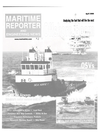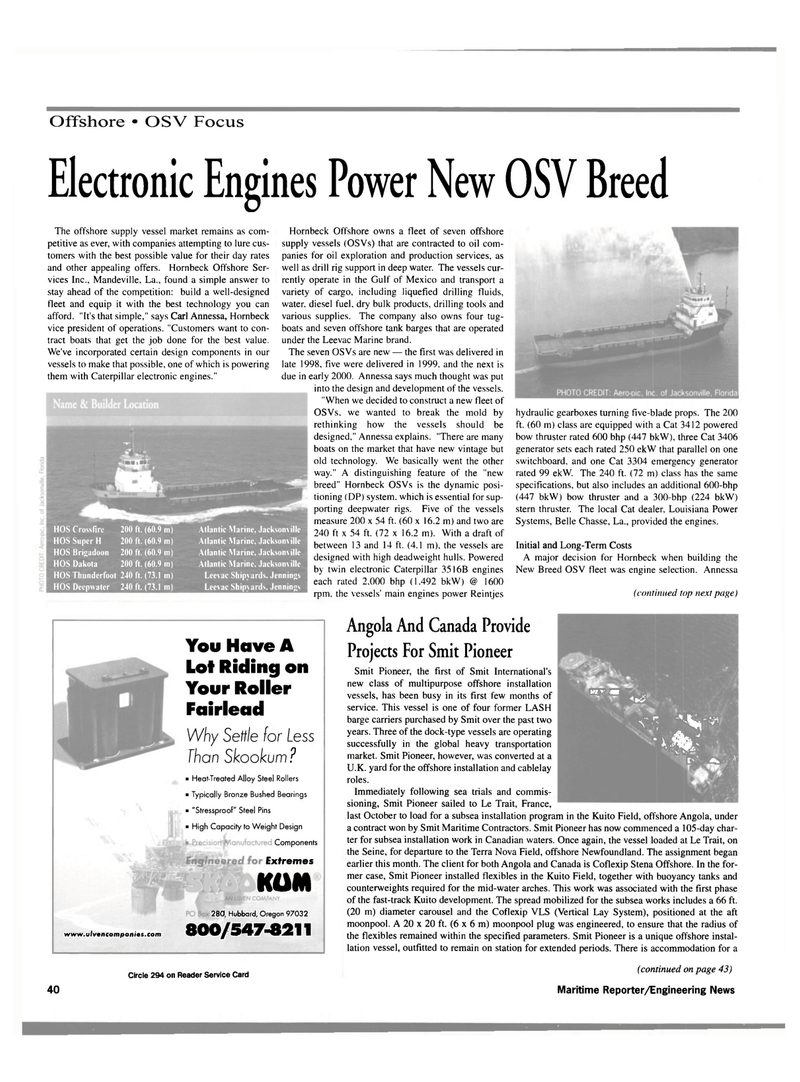
Page 40: of Maritime Reporter Magazine (April 2000)
Read this page in Pdf, Flash or Html5 edition of April 2000 Maritime Reporter Magazine
Offshore • OSV Focus
Electronic Engines Power New OSV Breed
The offshore supply vessel market remains as com- petitive as ever, with companies attempting to lure cus- tomers with the best possible value for their day rates and other appealing offers. Hornbeck Offshore Ser- vices Inc., Mandeville, La., found a simple answer to stay ahead of the competition: build a well-designed fleet and equip it with the best technology you can afford. "It's that simple," says Carl Annessa, Hornbeck vice president of operations. "Customers want to con- tract boats that get the job done for the best value.
We've incorporated certain design components in our vessels to make that possible, one of which is powering them with Caterpillar electronic engines."
Hornbeck Offshore owns a fleet of seven offshore supply vessels (OSVs) that are contracted to oil com- panies for oil exploration and production services, as well as drill rig support in deep water. The vessels cur- rently operate in the Gulf of Mexico and transport a variety of cargo, including liquefied drilling fluids, water, diesel fuel, dry bulk products, drilling tools and various supplies. The company also owns four tug- boats and seven offshore tank barges that are operated under the Leevac Marine brand.
The seven OSVs are new — the first was delivered in late 1998, five were delivered in 1999, and the next is due in early 2000. Annessa says much thought was put into the design and development of the vessels. "When we decided to construct a new fleet of
OSVs, we wanted to break the mold by rethinking how the vessels should be designed," Annessa explains. "There are many boats on the market that have new vintage but old technology. We basically went the other way." A distinguishing feature of the "new breed" Hornbeck OSVs is the dynamic posi- tioning (DP) system, which is essential for sup- porting deepwater rigs. Five of the vessels measure 200 x 54 ft. (60 x 16.2 m) and two are 240 ft x 54 ft. (72 x 16.2 m). With a draft of between 13 and 14 ft. (4.1 m), the vessels are designed with high deadweight hulls. Powered by twin electronic Caterpillar 3516B engines each rated 2.000 bhp (1.492 bkW) @ 1600 rpm, the vessels' main engines power Reintjes hydraulic gearboxes turning five-blade props. The 200 ft. (60 m) class are equipped with a Cat 3412 powered bow thruster rated 600 bhp (447 bkW), three Cat 3406 generator sets each rated 250 ekW that parallel on one switchboard, and one Cat 3304 emergency generator rated 99 ekW. The 240 ft. (72 m) class has the same specifications, but also includes an additional 600-bhp (447 bkW) bow thruster and a 300-bhp (224 bkW) stern thruster. The local Cat dealer, Louisiana Power
Systems, Belle Chasse, La., provided the engines.
Initial and Long-Term Costs
A major decision for Hornbeck when building the
New Breed OSV fleet was engine selection. Annessa (continued top next page)
HOS Crossfire 200 ft. (60.9 m)
HOS Super H 200 ft. (60.9 m)
HOS Brigadoon 200 ft. (60.9 m)
HOS Dakota 200 ft. (60.9 m)
HOS Thimderfoot 240 ft. (73.1 m)
HOS Deepwater 240 ft. (73.1 m)
Atlantic Marine, Jacksonville
Atlantic Marine, Jacksonville
Atlantic Marine, Jacksonville
Atlantic Marine, Jacksonville
Leevac Shipyards, Jennings
Leevac Shipyards, Jennings ™ ™ .x? ^ r. • ^ - v - V •a; »?
I " At t< ,'V
You Have A
Lot Riding on
Your Roller
Fairlead
Why Settle for Less fhon Skookum ?
Angola And Canada Provide
Projects For Smit Pioneer
Circle 294 on Reader Service Card 40
Smit Pioneer, the first of Smit International's new class of multipurpose offshore installation vessels, has been busy in its first few months of service. This vessel is one of four former LASH barge carriers purchased by Smit over the past two years. Three of the dock-type vessels are operating successfully in the global heavy transportation market. Smit Pioneer, however, was converted at a
U.K. yard for the offshore installation and cablelay roles.
Immediately following sea trials and commis- sioning, Smit Pioneer sailed to Le Trait, France, last October to load for a subsea installation program in the Kuito Field, offshore Angola, under a contract won by Smit Maritime Contractors. Smit Pioneer has now commenced a 105-day char- ter for subsea installation work in Canadian waters. Once again, the vessel loaded at Le Trait, on the Seine, for departure to the Terra Nova Field, offshore Newfoundland. The assignment began earlier this month. The client for both Angola and Canada is Coflexip Stena Offshore. In the for- mer case, Smit Pioneer installed flexibles in the Kuito Field, together with buoyancy tanks and counterweights required for the mid-water arches. This work was associated with the first phase of the fast-track Kuito development. The spread mobilized for the subsea works includes a 66 ft. (20 m) diameter carousel and the Coflexip VLS (Vertical Lay System), positioned at the aft moonpool. A 20 x 20 ft. (6 x 6 m) moonpool plug was engineered, to ensure that the radius of the flexibles remained within the specified parameters. Smit Pioneer is a unique offshore instal- lation vessel, outfitted to remain on station for extended periods. There is accommodation for a (continued on page 43)
Maritime Reporter/Engineering News • Heat-Treated Alloy Steel Rollers • Typically Bronze Bushed Bearings • "Stressproof" Steel Pins • High Capacity to Weight Design
Components
Extremes
KOM 280, Hubbard, Oregon 97032 800/547-8211 www.ulvencomponies.com

 39
39

 41
41
